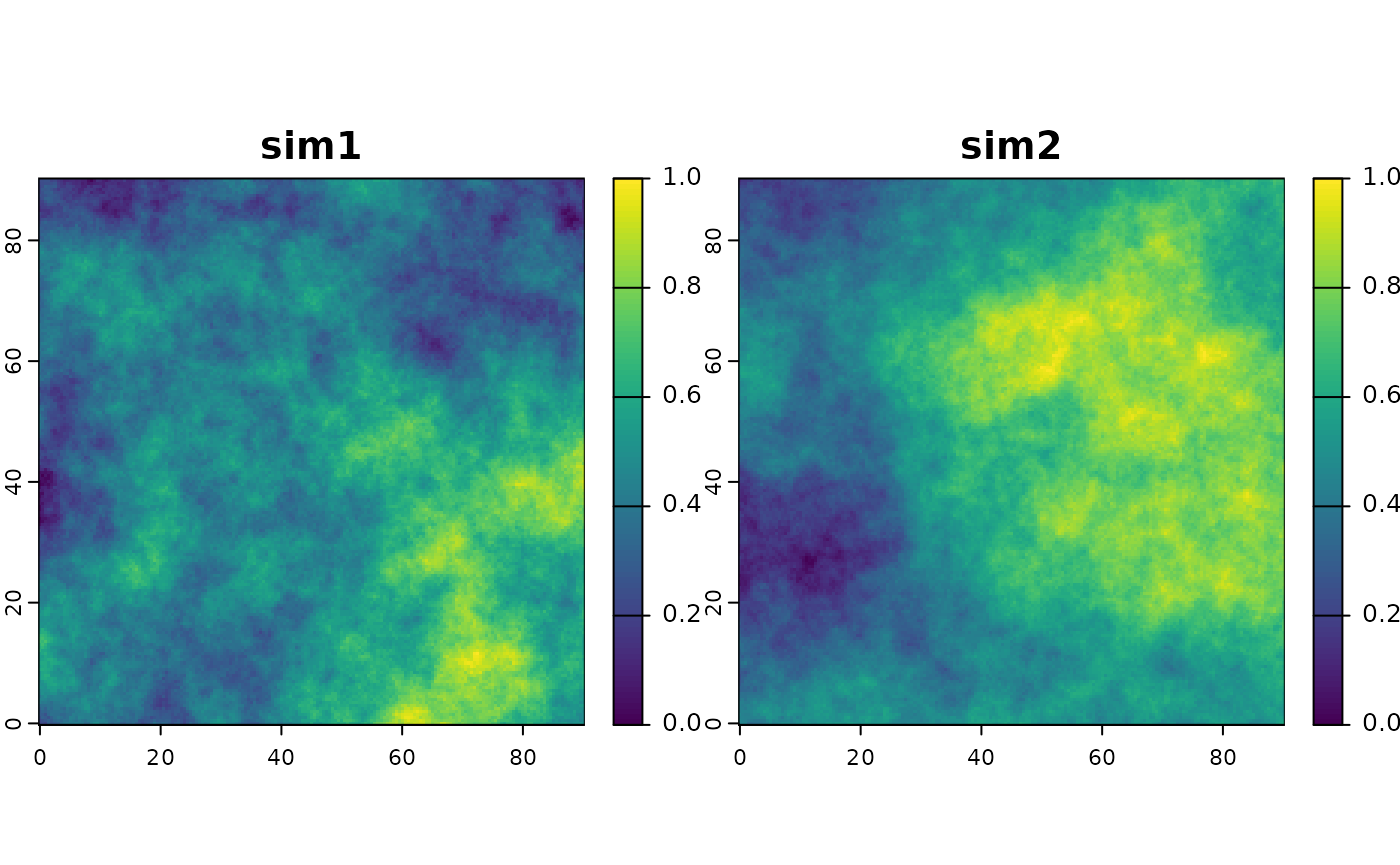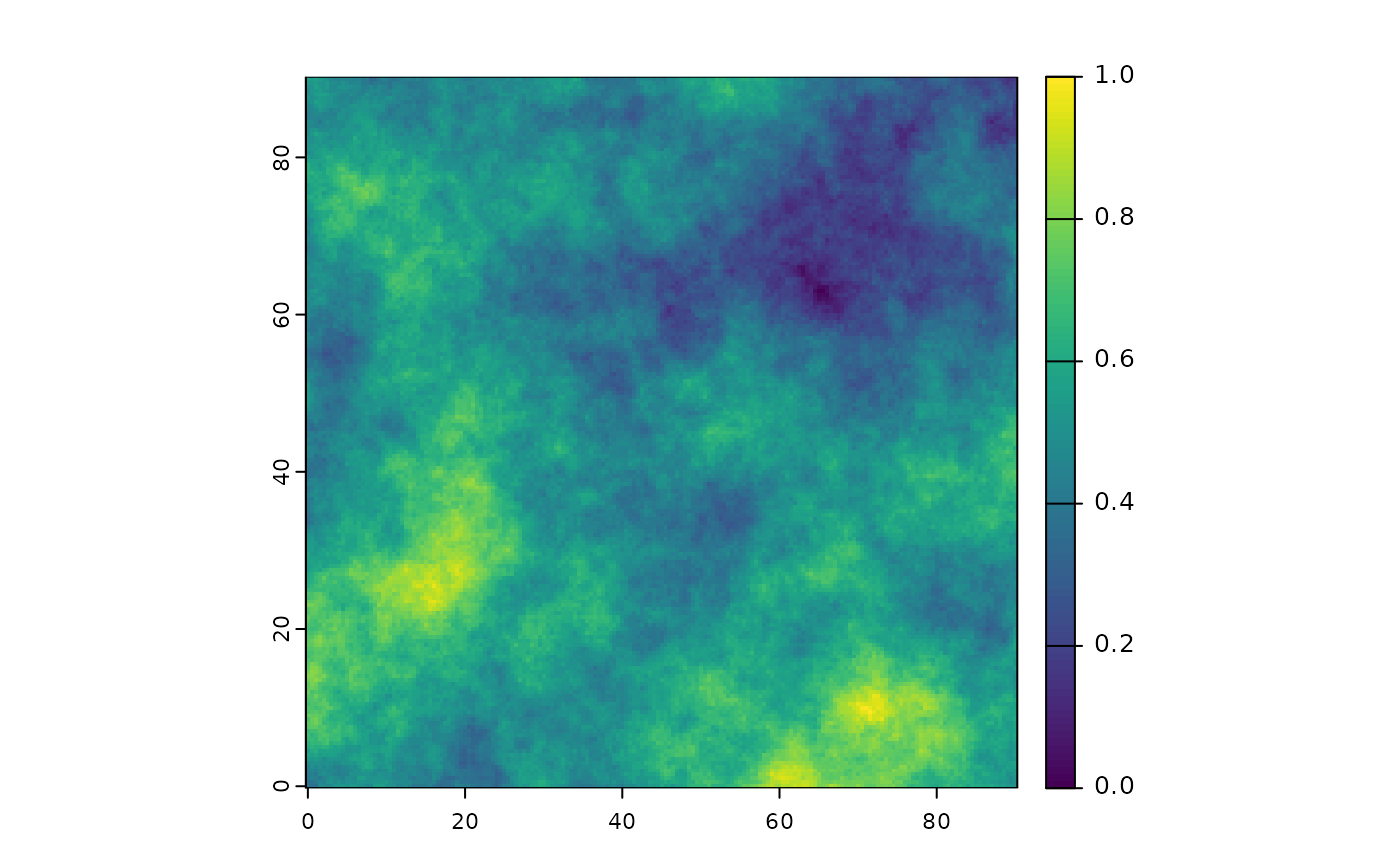
Simulate virtual environment
simulate-virtual-environment.Rmd
library(virtualecologist)Create the grid
Create the grid structuring the virtual environment. By default,
create_grid() creates a grid spanning 0 to 90° in both
longitude and latitude, with steps of 0.5.
grid <- create_grid()Generating environmental layers
The generate_env_layer() function creates several
environmental layers using Gaussian simulation from the grid locations.
The number of layers generated is set by n. The generated layers can be
normalised, and be returned either only as data frame or both in data
frame and raster formats (SpatRast).
grid <- create_grid()
str(generate_env_layer(norm = FALSE, return_rasters = FALSE, grid = grid))
#> [using unconditional Gaussian simulation]
#> 'data.frame': 32761 obs. of 4 variables:
#> $ x : num 0 0.5 1 1.5 2 2.5 3 3.5 4 4.5 ...
#> $ y : num 0 0 0 0 0 0 0 0 0 0 ...
#> $ sim1: num 4.7 5.35 4.82 7.42 6.74 ...
#> $ sim2: num -0.381 -0.575 -0.766 -3.876 -4.276 ...
library(terra)
#> terra 1.7.78
plot(generate_env_layer(norm = TRUE, return_rasters = TRUE, grid = grid)$rasters)
#> [using unconditional Gaussian simulation]
Build the suitability layer
The generate_resource_layer() function permits building
a suitability layer from a set of environmental layers and beta
parameters to be leveraged with. It mimics a basic resource selection
function, where a given environmental layer is simply scaled by the beta
parameter (env*beta) and several leveraged env layers are additively
combined. For more elaborate procedures, see the virtualspecies
package.
library(terra)
# simple example
grid <- create_grid()
cdt <- generate_env_layer(grid = grid)
#> [using unconditional Gaussian simulation]
rsce <- generate_resource_layer(env_layers = cdt$rasters,
beta = c(2, -1.5))
str(rsce)
#> List of 2
#> $ dataframe:'data.frame': 32761 obs. of 3 variables:
#> ..$ x : num [1:32761] 0 0.5 1 1.5 2 2.5 3 3.5 4 4.5 ...
#> ..$ y : num [1:32761] 90 90 90 90 90 90 90 90 90 90 ...
#> ..$ suitability: num [1:32761] 0.566 0.546 0.56 0.554 0.527 ...
#> $ rasters :S4 class 'SpatRaster' [package "terra"]
plot(rsce$rasters)
# also works when coordinates are not names x,y
cdt2 <- generate_env_layer(grid = grid, n = 3)$dataframe |> dplyr::rename(lon = x, lat = y)
#> [using unconditional Gaussian simulation]
str(generate_resource_layer(env_layers = cdt2, coordinate_fields = c("lon", "lat"),
beta = c(2, -1.5, 3)) )
#> List of 2
#> $ dataframe:'data.frame': 32761 obs. of 3 variables:
#> ..$ lon : num [1:32761] 0 0.5 1 1.5 2 2.5 3 3.5 4 4.5 ...
#> ..$ lat : num [1:32761] 0 0 0 0 0 0 0 0 0 0 ...
#> ..$ suitability: num [1:32761] 0.389 0.346 0.37 0.328 0.324 ...
#> $ rasters :S4 class 'SpatRaster' [package "terra"]